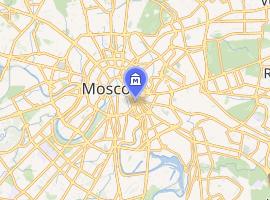Tagansky Protected Command Point
The Cold War Museum (Moscow) or Bunker GO-42, also known as "facility-02" (1947), CHZ-293 (1951), CHZ-572 (1953), and GO-42 (from 1980), and now Exhibition Complex Bunker-42[1], is a once-secret military complex, bunker, communication centre in Moscow, Russia, near the underground Moscow Metro station Taganskaya. It has an area of 7,000 square metres (75,000 sq ft) and is situated at a depth of 65 metres (213 ft) below ground.[2]
Model of the bunker layout | |

| |
| Established | 1956 |
|---|---|
| Location | 115172, Moscow, 5th Kotelnichesky Lane, 11 |
| Coordinates | 55.741735°N 37.649277°E |
| Type | Cold War Museum, restaurant |
| Public transit access | Taganskaya, 5 min walk |
| Website | Museum website |
History
Construction of the facility began in 1951, in connection with the early threat of nuclear war with the United States. The underground complex was built using the same technique that was used in the construction of the Moscow Metro subway, to which it is connected by two tunnels. The first tunnel was used to supply the facility, and connects to the subway at Taganskaya (circle line) station. The second tunnel connects to the technical areas of Taganskaya.[3]
In 1956, the facility operated as an emergency command post headquarters of Moscow antiaircraft district (PVO) communication center. Personnel at the facility, including technical staff, were changed over every 24 hours. The staff worked in short shifts in order to stay alert and prevent combat anxiety. According to recollections of veterans, many of the staff members worked for various other institutions, including the central telegraph, radio studio, and geodetic laboratory.[3] In the 1960s, the bunker was equipped with everything needed to continue operating in the event of a nuclear attack, including food, fuel, and two artesian wells to provide clean drinking water for an extended period of time.[3]
In the mid-1970s, it was decided to reconstruct part of the bunker to serve the needs of the central telegraph office. This was due to a backlog of maintenance issues in the complex, such as a lack of waterproofing, and aging diesel generators and ventilation systems. These plans were never carried out, however, and the bunker was declassified in 2000.
The 2001 Russian federal budget earmarked one million rubles for capital investments in the site.[4]
Transfer to private ownership
In 2006, the bunker was put up for public auction by the Russian Federal Agency for State Property Management. It was purchased by a private company, Novick-Service, for 65 million rubles. Novick-Service plans to turn it into an entertainment complex with a museum of the Cold War, a restaurant, and possibly a spa. The only objects left unaltered are a massive steel door, and steel paneling in the bunker. As of April 2007, it is possible to book excursions around the 600-metre-long network of tunnels. As of March 2012, renovations were still in progress, but part of the bunker had been finished.
Capacity
Approximately 600 people could live and work in the complex for 30 days without assistance from the outside world, thanks to stores of food and medicine, an air recycling system, and diesel generators. Workers would commute to the facility by way of the Taganskaya metro station, on special trains that ran at night.
See also
- Detachment Hotel
- Emergency Government Headquarters - in Canada
- The Cold War Museum – a Cold War museum in Warrenton, Virginia
- Plokštinė missile base – a Cold War museum in Lithuania
References
- "About the Bunker 42 museum".
- Malpas, Anna (2007-04-20). "CONTEXT - Underground Marvels". The Moscow Times. Retrieved 2007-04-20. (subscription required)
- Archive chief engineer of the GO-42: Explanatory note to the reconstruction of the object CZ-293 Moscow, Metrogiprotrans, 1973
External links
- Photos of the bunker - Flickr.com
- Moscow bunkers - https://www.bunkermoscow.ru